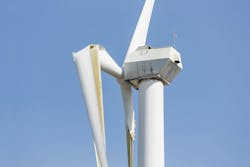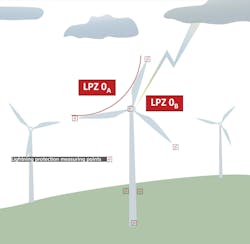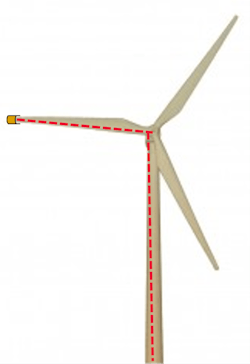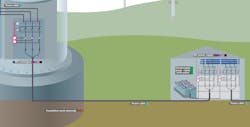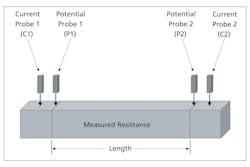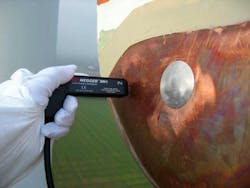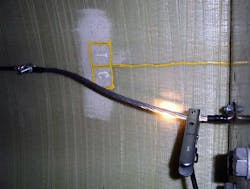The share of wind power in total electric power generation is expected to increase, and with that comes a requirement for this carbon-free source to be more reliable. The most important component of a wind power system, the wind turbine, is exposed to harsh environmental conditions and electrical transients such as lightning strikes. Understanding the lightning protection scheme of the wind turbine and checking its integrity is vital to ensuring reliable operations. Recent international studies have shown 80% of insurance claims on wind turbines in one European country resulted from lightning-related damage. Similarly, a major U.S. utility reported over 85% of its wind turbine downtime was from lightning-related damage.
Wind turbine manufacturers take great care in designing the lightning protection system. Turbine owners and operators should ensure the system has been installed correctly and regularly check it is working properly as part of their maintenance program.
Wind Power
Renewable energy is growing at a rapid pace. In 2020, new installations of wind power provided 93 GW globally. The year-over-year growth is 53% with both the U.S. and China leading the world in new installations of wind power generation. Wind power answers the pressing needs and circumstances of the day. It is a relatively inexpensive and green energy source that addresses constrained infrastructure budgets as well as climate-change policies. Most market analysts indicate wind power development will continue to grow at a fast rate — because all the driving factors of its adoption continue to persist. This is great news for the electric power industry, as there will be growth and opportunity for many years to come. However, this growth will need improved maintenance programs to protect the investments in wind power and maximize the profits.
Lightning Protection
The biggest maintenance problem for wind power is lightning strikes. According to Vestas CEO Henrik Andersen, intense lightning strikes were the biggest driving force behind the record warranty claims of €175 million (US$212 million) in the second quarter of 2020. Wind turbine manufacturers and installers like Vestas recognize the immense danger of lightning strikes and take great care in the design of turbines. Still, operators and owners of wind turbines must ensure a robust and effective maintenance program for their assets.
A growing number of studies speculate rotating wind turbines may be more susceptible to lightning strikes than stationary structures. Wind turbines are at an increased risk of being struck by lightning because of their height and the locations used for wind farms. Lightning faults cause more loss in wind turbine availability and production than the average fault.
Wind turbines are equipped with lightning protection to minimize damage from direct lightning strikes, and shield sensitive equipment integral to wind turbine operation. A lightning strike not only has a large magnitude of current but also creates an unwanted electromagnetic field across components housed in the nacelle and base of the tower. The lightning protection system performs the function of directing current strikes to ground.
To facilitate the coordination of protection functions, it is prudent to divide the wind turbine into different zones, known as lightning protection zones (LPZ). The LPZ concept is a structuring measure for creating a defined electromagnetically compatible environment in an object while being cognizant of the object’s stress-withstand capability.
IEC 62305 Standard for Lightning Protection defines the LPZ for structures and can be applied to a wind turbine. The different zones are classified into external and internal zones based on their exposure to direct lightning.
External Zones
The external zones consist of the following:
- LPZ 0A — This is the zone that could be threatened by direct lightning flashes and the full lightning
electromagnetic field. The internal systems may be subjected to full lightning surge current. - LPZ 0B — This zone is protected against direct lightning flashes, but the full lightning electromagnetic field remains a threat. The internal systems may be subjected to partial lightning surge currents.
The rolling sphere method is used to determine LPZ 0A, the parts of a wind turbine that could be subjected to direct lightning strikes, and LPZ 0B, the parts of a wind turbine that are protected from direct lightning strikes by external air-termination systems or air-termination systems integrated in parts of a wind turbine (for example, in the rotor blade).
Internal Zones
- LPZ 1 — The surge current in this zone is limited by current sharing and isolating interfaces, as well as by surge protection devices (SPD) at the boundary. Spatial shielding may attenuate the lightning electromagnetic field.
- LPZ 2 to LPZ n — The surge current may be further limited in this zone by current sharing and isolating interfaces, as well as by additional SPDs at the boundary. Additional spatial shielding may be used to further attenuate the lightning electromagnetic field.
The lightning protection system essentially works by taking the form of a low-resistance path to ground. The path goes from the blade’s tip to the base of the turbine.
In the event of a lightning strike, current flows to ground through the lightning protection system, not the sensitive equipment in the wind turbine. As the lightning current dissipates through the grounding system, it is important not to cause thermal or mechanical damage or arcing that may lead to fires or personnel injuries. To ensure protection in the zones will work when needed, the resistance of the path to ground should be measured at regular intervals, ensuring it meets the limits specified by the turbine manufacturer (typically limited to 15 mΩ to 30 mΩ, depending on the turbine size). For these tests, use of a low-resistance ohmmeter is recommended.
Verification Methods
Measurement of low resistance is affected by key factors such as measurement type, test current magnitude, length of measurement leads, and placement of leads and probes. The four-wire method is most appropriate because it uses separate current probes to inject direct current and separate potential probes to measure the voltage drop across the test specimen.
In some practical cases, a Kelvin measurement — where current and potential probes are 180 degrees apart — also is employed to measure low-resistance values. The use of any other methods, such as a two-wire method, may not be suitable because the measurement contains contact resistance values of the probes, thereby clouding the measurement.
Testing The Protection
The most important part of the lightning protection system is to test the conductor from the blade tip to the down conductor inside the hub that ultimately connects to the ground grid. The conductor is placed under significant strain when the blade flexes with the wind during normal operation. Under strain, the conductor could fracture. Unfortunately, it is not enough to simply check continuity, because if the fractured conductor is touching at the break point during a continuity test, the result will not be satisfactory. Consequently, a test current magnitude of 1 A or more is recommended for this test.
The size of the turbines can pose a problem because low-resistance ohmmeter test leads typically are very short. Because of the size of the wind turbines, some extra-long leads are required, often up to 100 m (328 ft). This is a huge increase in length over standard test leads for low-resistance ohmmeters. The long leads must be designed with a low enough resistance to ensure a measurement is still possible. To achieve this, it is important to understand the test instrument design.
Some instruments have a compensation factor to allow for power loss in standard test leads. When using long test leads, the compensation for power loss will no longer be sufficient. As a result, the test range of the instrument will be reduced. When the resistance of the test leads increases, the total value of the resistance of load also increases, as shown in this equation:
P = I 2 R, where R = (resistance of load) + (resistance of test leads), P = output power of the test instrument and I = output current of the test instrument.
Since the maximum power output of the test equipment cannot change, the rise in test lead resistance will cause the maximum current to be reduced. Lead length impacts the ability of an instrument to measure low resistances. Accurate and repeatable measurements will be a combination of test current, lead length and resolution.
The performance of the low-resistance tester at 1A (2.5 W) is most desirable for lead lengths typically used to measure wind turbine lightning protection systems. For wind turbine applications, use the proper range and test current magnitude because it the length of measurement leads accommodate the length of the wind turbine’s blades.
Results
Testing of the lightning protection system was performed on a wind turbine with 32-m-long (105-ft-long) blades using a low-resistance ohmmeter. The instrument was used in its long-test-lead mode, which applies a 1-A test current and can measure accurately down to 0.01 mΩ when using 100-m-long (328-ft-long) test leads. The lightning system testing consisted of measuring the system’s resistance from the tip of each blade to the hub and from the hub to the base. The lightning system terminates with interconnected ground rods at the base of the turbine tower.
Each measurement was taken three times to evaluate repeatability. The variance meter on the instrument automatically recorded three measurements in a row and calculated their variance. The low variance provides confidence in the measurement. In the field, test engineers must take care to remain safe and follow best practices. This will provide the best possible measurements.
The manufacturer of this wind turbine provided a pass level for the lightning system of 20 mΩ or less. This test proves the lightning system had been installed correctly and was in good working order. Therefore, this turbine had good lightning protection as per the manufacturer’s design.
Recurring Maintenance
Lightning is a damaging threat to wind turbines. As wind power installations continue increasing around the world, the requirement to protect these assets becomes even more important. Manufacturers of wind turbines take great care in designing their lightning protection system, because of the known damage that lightning can cause. Owners and operators of turbines must ensure the lightning protection system has been installed correctly. Additionally, they must regularly check the lightning protection system as part of their maintenance program.
Testing and verifying the lightning protection system’s effectiveness is based primarily on low-resistance measurements. Some challenges exist in measuring resistances at the milliohm level when dealing with large structures like wind turbines, so a balance between test energy, accuracy, resolution and test lead length must be established. However, the right tools for the task can make this a simple job. Lightning protection maintenance should be a regular recurring task for owners and operators. This will avoid lightning damage to wind turbines and ensure these assets are protected.
Acknowledgement
This article was provided by the InterNational Electrical Testing Association. NETA was formed in 1972 to establish uniform testing procedures for electrical equipment and systems. Today the association accredits electrical testing companies; certifies electrical testing technicians; publishes the ANSI/NETA Standards for Acceptance Testing, Maintenance Testing, Commissioning, and the Certification of Electrical Test Technicians; and provides training through its annual PowerTest Conference and library of educational resources.
Sameer Kulkarni, PE, ([email protected]) is is the engineering supervisor for the Electrical Design Engineering group at ENERCON. He has nine years of experience in electrical engineering across nuclear power generation and electrical testing. Kulkarni has led the design and implementation of electrical projects across several nuclear plants and has extensive experience in testing power transformers, current and potential transformers, batteries, circuit breakers, inverters, motors, relays and analyzing test results.
Dr. Ahmed El-Rasheed ([email protected]) is a business development director at Megger and has over 14 years of experience in electrical engineering. He is a member of several international standards organizations and has published papers on ground testing, insulation testing and multi-sensor integration using AI.

